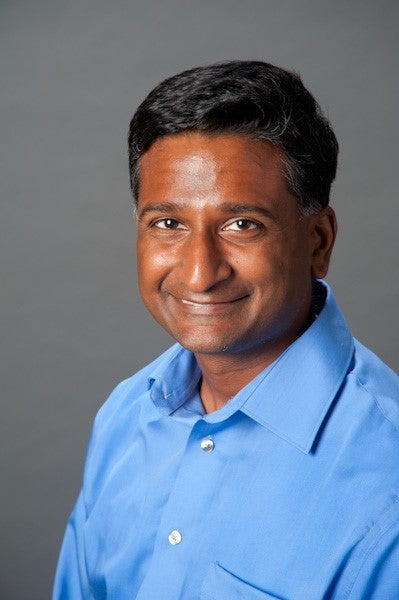From Engineer to Lawyer, Get to Know Dana Rao, Adobe’s General Counsel

Appointed to executive vice president, general counsel, and corporate secretary in June 2018, Dana Rao is applying his more than 20 years of legal experience to lead Adobe’s Legal and Government Relations team and help take Adobe into its next chapter of industry leadership.
We talked to Dana to learn more about his unique background, circuitous career path, and his goals to drive Adobe’s business forward.

You have lead Adobe’s IP and Litigation team for 6 years and now you are taking on a new role as the General Counsel. What excites you about the leadership position?
I’m thrilled to be part of the leadership team that is looking at the next era of Adobe’s offerings. The company is at an amazing inflection point, where we are in a leadership position to scale our business and drive the next wave of innovation that can change the world.
As a leader, my purpose is to drive Adobe’s business forward. To help lead the next chapter of Adobe’s business, I’m focused on 3 key areas: Operating at Scale, Public Policy, and Emerging Technologies.
The company is growing faster than ever, with a global reach, and my goal is to focus on new and innovative ways to deliver legal services that scale in this complex environment. Whether that is through tools, organizational structures, partnerships, or policies, we will need to do more with more. Having been part of a legal organization that operated at scale while at Microsoft, I look forward to drawing on those experiences to elevate the legal org’s role in enabling global business growth.
Public policy and communications are overlooked tools that the Legal department can use to help drive a company’s agenda forward. It’s great to win a case, but much greater impact will come from changing the law on which the case was based. Educating our lawmakers and policymakers about the impact and value of our technology will help ensure regulations focus on areas where governments can do the most good: access for all, fairness, and diversity. And shift focus away from regulations that forestall innovation through prematurely conceived processes.
As a former head of IP, I am personally passionate about the potential of emerging technologies, such as machine learning and artificial intelligence, in creating new and unexpected customer value in our products. The world ahead will look nothing like the world we experience today. My team will continue to sharpen its focus on cutting edge legal issues in privacy, data security, and intellectual property to ensure our products and services can do the right thing by our customers with these modern technologies.
You have a storied background – from being an engineer, to being on the campaign trail, to working your way up in the corporate legal environment. Tell us about your career journey?
My father was the Chairman of Electrical Engineering at Villanova. He told me I could apply to any college I wanted to, but I would be going to Villanova (since it was free). While my grades reflected that I was stronger in English than in Math, I also like to understand how things (TVs, appliances, radios, first gen PCs) work, so I majored in Electrical Engineering. Not to mention it made my dad happy.
My first job after college was at GE Astrospace as a radio-frequency engineer, designing ground stations that talk to satellites. Because of defense cutbacks at the time, the career path for engineers was difficult. And if you wanted to stay in engineering, you needed to move over to management. I decided if I was not going to be able to do the technical work, I might as well go all-in and not be technical.
I moved out to California to secure residency for graduate school and explored politics by volunteering on Bill Clinton’s campaign. I was hired to be the Deputy Director of Women’s Issues in California. Among my responsibilities was organizing celebrity coffee events to foster a dialogue and address the importance of voting. I’ll never forget my ‘celebrity moment’ when I was able to meet my TV mom from Family Ties, Meredith Baxter-Birney.
A colleague from the campaign moved to D.C. and said he had a job waiting for me – he didn’t. But while in D.C., I was fortunate to land a political appointment at the Justice Department. In the role, I helped with Native American issues, including trying to get Native Americans funding from the soon-to-be-passed Violence Against Women Act and holding the first ever listening conference between the Attorney General and the leaders of the 535 Federally recognized tribes. While this work was very rewarding, I soon realized (being quick on the uptake) that everyone at the Justice Dept. had a law degree and that I would not go far in that career without one.
I pursued my law degree at The George Washington University Law School and that launched my career as a lawyer at Fenwick & West, Microsoft, and Adobe.
But, if you asked my eight-year-old-self what I wanted to be…it was a waiter. I saw all the cash tips and figured that is where the money was at.
Throughout your career you have met several influential people and leaders. Who do you admire and why?
In my role at the Justice Dept., I had the privilege to work directly with the Attorney General at the time, Janet Reno. To this day, Janet Reno remains my hero for her unwavering integrity and compassion for varying perspectives.
Ms. Reno redefined the relationship between the Justice Dept. and Native American tribes to one based on partnership, support, and empathy. Given her background living in Florida, she was close to the Seminole tribe, and understood their issues and concerns. She brought that approach with her to her leadership role at the White House.
Amidst a politically charged climate, she always asked, “What is the right thing to do?” She did not care about political consequences.
This approach has guided the rest of my career and plays prominently in my role as Adobe’s GC. The question — “What is the right thing for Adobe?” — transcends turf and politics and career advancement. I know if my decisions are based on addressing that question, I will be doing the right thing for the business, our employees and our customers.
You are an ardent champion for cultivating diverse perspectives at Adobe and across the legal industry. Tell us why this is important to you?
This is extremely important to me and it requires some context. My mom and dad came over from India in the early sixties and my brother and I were born in the U.S. I spent my childhood in Philadelphia at a time when there weren’t a lot of Indian-Americans in the country. Early on, people would ask me where I am from. When I responded that I was from Philly, they would ask, “No, where are you really from?” So as a young boy I was aware that I was perceived as being different from them, and yet with the dearth of Indians around, I also didn’t have a group I could call my own.
Through my experiences at college and living in California I was exposed to people from all over the country with different experiences and backgrounds, and who were not sizing me up based on how I looked. This was a liberating and defining moment for me where I was able to let down my guard and truly embrace who I was. Which was, for the most part, a Philadelphian.
These life experiences have instilled in me the value of diverse perspectives that come from dissimilar backgrounds, ethnicities, cultures, and up-bringing. Putting someone in a box based on how they look thwarts passion, creativity and intellect. At the end of the day, we are 80% the same. The different 20% is our learning opportunity. So, given all we have in common, we need to celebrate our similarities and learn from our differences. When you meet someone new, whatever they look like, ask them “What is your story?” I guarantee that you will learn something to broaden your outlook.
This translates directly into my team. It’s important for me to have an atmosphere where no feels like they’re being judged or stereotyped, where they feel comfortable and can openly talk about their story, and where they can be completely authentic. That openness and comfort will allow people to become their best selves, and Adobe will benefit.
What would you be doing, if you weren’t the General Counsel of Adobe?
Here are some thoughts, all of which are co-extensive.
Finally finishing the book I started writing 15 years ago about teleportation, augmented reality, environmental disasters, and the end of the world.
Involved in the criminal justice system, helping to protect the rights of those that need it. Which my wife of 21 years currently does, and she has much better dinner stories than I.
And, never giving up on my dream of being able to dunk a basketball.